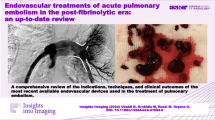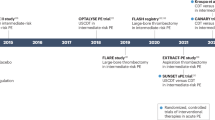Abstract
Pulmonary embolism is the most common cardiovascular disease after myocardial infarction and stroke. Konstantinides (Eur Heart J 41(4):543–603, 2020) Current guidelines categorize patients with PE as being at low, intermediate, and high risk of early death, with the intermediate-risk group experiencing the greatest uncertainty regarding treatment recommendations. Rapid reduction of the thrombus load by thrombolysis significantly reduces symptoms and decreases mortality, but is accompanied by a high risk of bleeding. Meyer (N Engl J Med 370(15):1402-11, 2014) Mechanical thrombectomy (CDTE) have been proven safe and efficient, yet current ESC guidelines suggest the utilization of catheter interventions only for hypotensive patients with high bleeding risk, failed systemic thrombolysis, and cardiogenic shock or if a patient does not respond to conservative therapy Konstantinides (Eur Heart J 41(4):543–603, 2020). Here, we report a case of an intermediate-risk patient with pulmonary embolism who underwent thrombus aspiration and showed significant improvement in symptoms after treatment.
Similar content being viewed by others
Introduction
Treatment in the population with intermediate-risk pulmonary embolism is unclear, and the prevailing view is that catheter intervention should be used only in hypotensive patients with a high risk of bleeding, failure of systemic thrombolysis, cardiogenic shock, or in patients with high-risk pulmonary embolism who are refractory to conservative treatment, and it is unclear whether catheter intervention should be used in the subacute stage of pulmonary embolism. We report a case of intermediate-risk pulmonary embolism in the subacute stage that underwent thrombus aspiration and showed significant improvement in symptoms after treatment.
Case presentation
A 25-year-old male presented with shortness of breath after activity for a month and a half, because of a history of vasculitis, he had been treated with oral hormones for a long time, and for which he had undergone femoral artery prosthetic bypass and right femoral artery endarterectomy 4 years ago. Computed tomographic pulmonary angiography (CTPA) demonstrated multiple emboli in the right main pulmonary artery and the right branch pulmonary artery as well as the left inferior pulmonary artery, which was then diagnosed as intermediate risk for pulmonary embolism (abnormally elevated troponin and NT-proBNP). CTPA was repeated 50 days after receiving adequate low-molecular heparin anticoagulation therapy and showed no significant reduction in pulmonary embolism (Fig. 1). Physical examination, transthoracic echocardiography and lower-limb compression ultrasonography were found no abnormalities. Laboratory tests, including D-dimer, NT-proBNP, markers of myocardial injury, tumor markers of lung cancer, and autoantibody profile were not found to be abnormal. After evaluation by the multidisciplinary pulmonary embolism team, treatment with mechanical thrombectomy was considered due to poor anticoagulation, high surgical risk, and non-exclusion of thromboembolic pulmonary hypertension. Intraoperative pulmonary arteriogram showed complete occlusion of the right main pulmonary artery and incomplete occlusion of the left lower pulmonary artery(Fig. ;2), with a main pulmonary artery pressure of 60/15(32) mmHg. Mechanical thrombectomy was subsequently used to perform thrombus removal in the main pulmonary artery and the right lower pulmonary artery(Fig. ;3), catheter-directed thrombolysis was performed on the distal A1 segment of the right upper pulmonary artery, with a postoperative pulmonary artery pressure of 43/13(25) mmHg. CTPA showed a significant reduction in thrombus 3 days after surgery (Fig. 4), and standard dose rivaroxaban anticoagulation was continued postoperatively. Shortness of breath disappeared at 1 month follow-up, and CTPA demonstrated a reduction in thrombus. (Fig. 5)No adverse events such as bleeding occurred during the treatment.
Discussion
The occurrence of pulmonary embolism in this patient was associated with vasculitis, with no significant reduction of thrombus after 50 days of standard treatment, and even suspected pulmonary hypertension, which was subsequently confirmed in a right heart catheter. Catheter-directed thrombectomy is an effective therapeutic option for patients with PE who do not improve hemodynamically and clinically with anticoagulation or who are at risk for secondary deterioration. Mechanical thrombectomy has been previously described as safe and effective for the treatment of acute pulmonary embolism who with high risk of early death [3,4,5]. In our practice, mechanical thrombectomy in an intermediate-risk patient resulted in a satisfactory outcome and no adverse events. It’s worth noting that the patient in our case was a subacute pulmonary embolism in whom anticoagulation was not effective. To our knowledge, this is the first report that use mechanical thrombectomy for the treatment of subacute pulmonary embolism. Accordingly, we concluded that mechanical thrombectomy has shown promise in reducing the incidence of chronic thromboembolic pulmonary hypertension in patients with pulmonary embolism who have had poor results with anticoagulation therapy.
Conclusions
In patients in whom anticoagulation is ineffective in the acute phase of pulmonary embolism, the development of chronic thromboembolic pulmonary hypertension can be avoided by using interventional therapy in the subacute phase.
Data availability
Not applicable, case report.
References
Konstantinides SV, Meyer G, Becattini C, Bueno H, Geersing GJ, Harjola VP, Huisman MV, Humbert M, Jennings CS, Jiménez D, Kucher N, Lang IM, Lankeit M, Lorusso R, Mazzolai L, Meneveau N, Ní Áinle F, Prandoni P, Pruszczyk P, Righini M, Torbicki A, Van Belle E, Zamorano JL; ESC Scientific Document Group. 2019 ESC Guidelines for the diagnosis and management of acute pulmonary embolism developed in collaboration with the European Respiratory Society (ERS). Eur Heart J. 2020 Jan 21;41(4):543–603. https://doi.org/10.1093/eurheartj/ehz405. PMID: 31504429.
Meyer G, Vicaut E, Danays T, Agnelli G, Becattini C, Beyer-Westendorf J, Bluhmki E, Bouvaist H, Brenner B, Couturaud F, Dellas C, Empen K, Franca A, Galiè N, Geibel A, Goldhaber SZ, Jimenez D, Kozak M, Kupatt C, Kucher N, Lang IM, Lankeit M, Meneveau N, Pacouret G, Palazzini M, Petris A, Pruszczyk P, Rugolotto M, Salvi A, Schellong S, Sebbane M, Sobkowicz B, Stefanovic BS, Thiele H, Torbicki A, Verschuren F, Konstantinides SV; PEITHO Investigators. Fibrinolysis for patients with intermediate-risk pulmonary embolism. N Engl J Med. 2014 Apr 10;370(15):1402-11. https://doi.org/10.1056/NEJMoa1302097. PMID: 24716681.
Tu T, Toma C, Tapson VF, et al. A Prospective, Single-Arm, Multicenter Trial of Catheter-Directed Mechanical Thrombectomy for Intermediate-Risk Acute Pulmonary Embolism: The FLARE Study. JACC Cardiovasc Interv. 2019;12(9):859–869. https://doi.org/10.1016/j.jcin.2018.12.022.
Wible BC, Buckley JR, Cho KH, Bunte MC, Saucier NA, Borsa JJ. Safety and Efficacy of Acute Pulmonary Embolism Treated via Large-Bore Aspiration Mechanical Thrombectomy Using the Inari FlowTriever Device. J Vasc Interv Radiol. 2019;30(9):1370–1375. https://doi.org/10.1016/j.jvir.2019.05.024.
Toma C, Jaber WA, Weinberg MD, et al. Acute outcomes for the full US cohort of the FLASH mechanical thrombectomy registry in pulmonary embolism [published online ahead of print, 2022 Sep 18]. EuroIntervention. 2022;EIJ-D-22-00732. https://doi.org/10.4244/EIJ-D-22-00732.
Funding
This work was supported by the Natural Science Foundation of Guangdong Province (2023A1515010443), the Independent Subject Fund of the State Key Laboratory of Respiratory Diseases (SKLRD-Z-202313), and the Key Research and Development Program of Guangzhou Municipal Bureau of Science and Technology (2023B03J1387).
Author information
Authors and Affiliations
Contributions
Conceptualization, validation, writing—original draft preparation, J.H.; writing—review and editing,supervision, C.L. All authors have read and agreed to the published version of the manuscript.
Corresponding author
Ethics declarations
Ethical approval
Patient informed consent was obtained for this case report.
Informed consent
Patient informed consent obtained.
Competing interests
The authors declare no competing interests.
Additional information
Publisher’s Note
Springer Nature remains neutral with regard to jurisdictional claims in published maps and institutional affiliations.
Rights and permissions
Open Access This article is licensed under a Creative Commons Attribution 4.0 International License, which permits use, sharing, adaptation, distribution and reproduction in any medium or format, as long as you give appropriate credit to the original author(s) and the source, provide a link to the Creative Commons licence, and indicate if changes were made. The images or other third party material in this article are included in the article’s Creative Commons licence, unless indicated otherwise in a credit line to the material. If material is not included in the article’s Creative Commons licence and your intended use is not permitted by statutory regulation or exceeds the permitted use, you will need to obtain permission directly from the copyright holder. To view a copy of this licence, visit http://creativecommons.org/licenses/by/4.0/. The Creative Commons Public Domain Dedication waiver (http://creativecommons.org/publicdomain/zero/1.0/) applies to the data made available in this article, unless otherwise stated in a credit line to the data.
About this article
Cite this article
He, J., Liu, C. Aspiration of thrombus for intermediate-risk subacute pulmonary embolism. J Cardiothorac Surg 19, 188 (2024). https://doi.org/10.1186/s13019-024-02648-4
Received:
Accepted:
Published:
DOI: https://doi.org/10.1186/s13019-024-02648-4









